The Tiger tank no doubt holds the title of the most famous German tank of WW2. The tank is often mentioned as an example of the idea of “quality over quantity”, Tiger aces widely known, and the tanks and battles they fought in are often recreated in movies and video games. However, a more dangerous opponent appeared on the battlefield in July of 1943. The Panther tank had more effective front armour, a more powerful gun, and most importantly the odds of running into a Panther was much higher. The Allies spent a lot of time and effort on finding out its weaknesses. This article will cover the results of British investigations.
A mysterious enemy
Panthers first appeared on the Eastern Front. The Western Allies found out about it pretty quickly from the July 24th 1943 edition of the Red Star newspaper. The information contained in this article was imprecise, but the information exchange continued. More or less accurate information was available by September, and in December of 1943 the British came across a treasure trove. A notebook belonging to a scout from the 26th Reconnaissance Battalion that contained notes on the tank’s characteristics fell into the hands of the 8th Army in Italy. The British discovered that the tank fired three kinds of rounds: armour piercing, subcaliber, and high explosive. The armour piercing rounds were effective at a range of up to 2000 metres, but in some cases it was permitted to fire at a range of 2500 metres. The armour piercing shell penetrated up to 138 mm of armour at an angle (the angle was not noted). Subcaliber shot could be used to engage heavily armoured targets at a range of under 2000 metres. It penetrated up to 194 mm of armour. The high explosive round had a range of up to 4000 metres. The scout noted that the HE shell could not deal significant damage to an enemy tank but could still jam the turret of a Matilda or T-34 tank with a good hit.
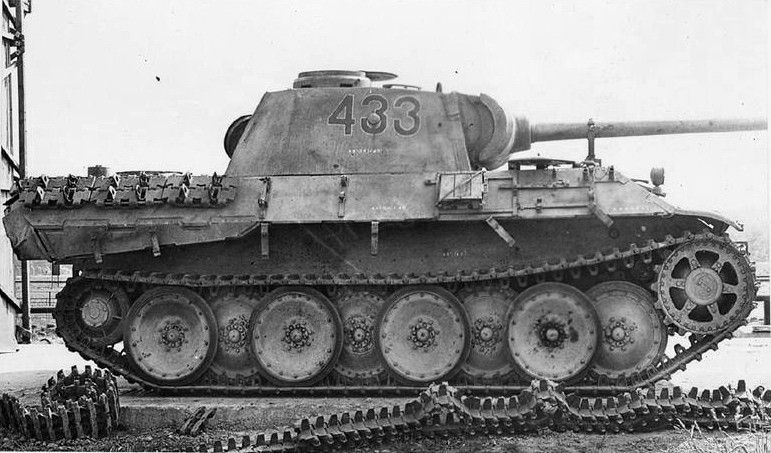
This information did not come in handy any time soon, as the British had yet to encounter a Panther tank. Here is where the USSR helped once more. A captured Panther with turret number 433 was sent to the UK. While the tank was undergoing mobility trials, the British composed their own technical description. They noted the tank’s dimensions, thickness of armour, and dovetail joints between plates. It was also noted that several Panther had a machine gun ball mount in the upper front plate. The description was finished in late May of 1944, and at this point it could change very little. In less than a week British tankers would have begun their landing in Normandy, where Panthers were a quite common phenomenon.
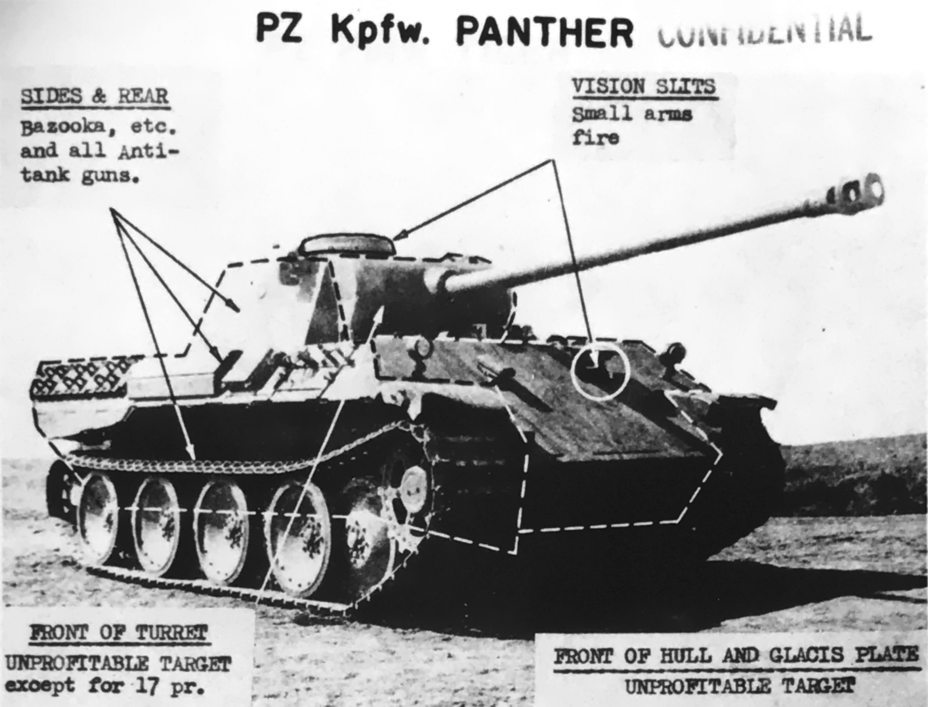
Existing information about the Panther was confirmed quite quickly. The Americans handed a thorough description of a Panther Ausf.A tank to British intelligence on July 24th, 1944. The tank was disabled with a hand grenade and remained in good condition. The radio and one machine gun were removed prior to inspection. Specialists confirmed the presence of a machine gun ball mount and a new lowered commander’s cupola with periscopes instead of vision slits. 40 AP and 32 HE rounds were found in the tank. Sight markings indicated that the tank could also fire subcaliber Pzgr.40/42 shot, but no rounds with it were found. Unlike the binocular sight of the Panther Ausf.D, the “model A” as the Americans called it had a T.Z.F.12a monocular sight and a new 690 hp engine. Photos of the new Panther commander’s cupola were passed on to Canadian intelligence. They responded that the Canadian tankers also wanted a hatch flap that could allow them to peek out of their tanks while retaining protection from above.
The T.Z.F.12a sight was retrieved from the tank and sent to Great Britain for trials. Analysis from the Experimental Wing of the AFV School revealed that the sight had two levels of magnification: 2.5 and 5x. The field of view was 30 and 15 degrees respectively. It was easy to change magnification, but the gunner could no longer see the sight markings at 5x zoom. The hard rubber pad also made it difficult to aim, as the gunner had to apply a lot of effort to put his head in the right place.
A T.S.R.1 commander’s periscope with 6x magnification and a field of view of 6 degrees was also recovered from a Panther tank. The British concluded that this device was ill-suited for fire correction.

Another variant of the Panther tank was discovered soon after: the Panther Ausf.G. This tank had thicker armour. The lower front plate was now 75 mm thick at 55 degrees (compared to 60 mm on the Ausf.D and Ausf.A). The gun mantlet was also thickened to 120 mm. Two Panthers of this type examined by the British did not have this thicker armour, but all three Ausf.Gs had thicker sides: 50 mm at 30 degrees instead of 40 mm at 40 degrees. The front 30 cm of the roof was also thicker: 40 mm instead of 15. The floor was 26 mm thick compared to 18 in earlier tanks. Unlike the Panther Ausf.D that came from the USSR, which had surface hardened armour, all Panthers Ausf.A and Ausf.G were built from homogeneous armour. The report author noted that surface hardening of sloped armour is pointless. He also noted that the thicknesses were nominal, as any plate could be up to 5% thicker.
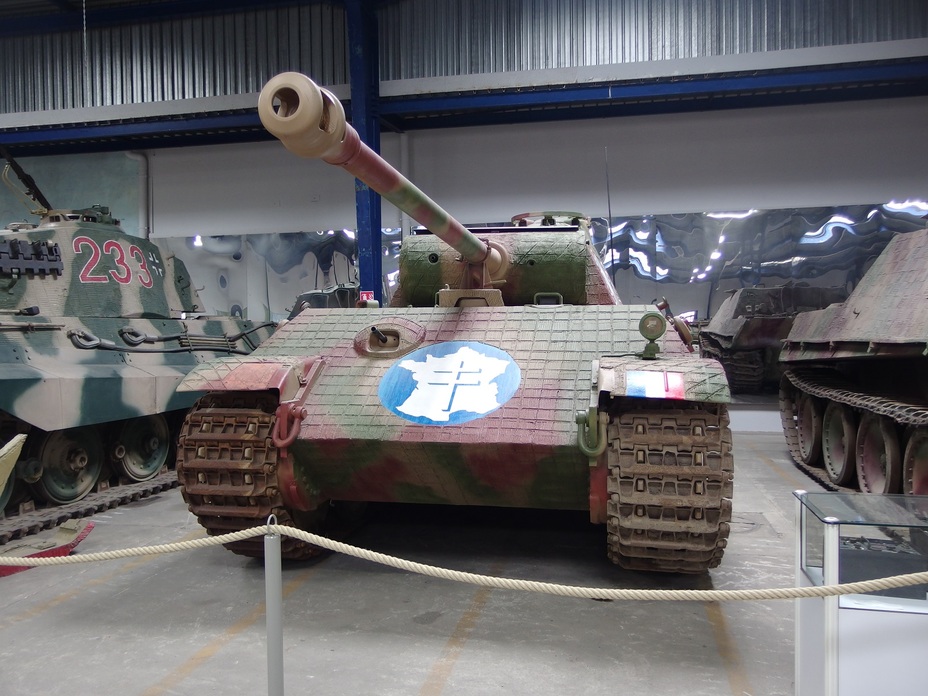
The Panther Ausf.G had the same machine gun in a ball mount as the Ausf.A, but the driver’s vision port was removed. Now the driver could only look through a periscope. His hatch flap was simplified and could no longer offer protection from above when partially opened. The British also noticed the appearance of 3 mm thick armour around the ammunition bins and a lack of pistol ports. The large hatch for loading ammunition in the side of the turret also disappeared.
Pelt and claws
The British composed the Panther’s family tree for a reason. Their aim was not just to learn to fight the tanks as they were now, but also chart the development of the tank and try to predict future changes, like they did with the Pz.Kpfw.III and Pz.Kpfw.IV in North Africa. Specialists from the Royal Armoured Corps studied the Panther that arrived from the USSR and performed calculations to evaluate the tank’s protection. The weakest area frontally was the gun mantlet. 6-pounder APCBC shot could penetrate it from 600 yards at normal, but would not be able to do that at 30 degrees. The American 76 mm gun could penetrate the mantlet from 500 yards at normal, but could still penetrate it from 200 yards at 30 degrees. The 17-pounder could penetrate it even at that angle from 2000 yards. Calculations showed that even this gun would not be able to penetrate the upper or lower front plates. It was easiest to knock out the tank from the side. Any of the aforementioned weapons could penetrate the hull and turret side armour from over 2000 yards at an angle of 30 degrees. The 6-pounder was the only exception, as it could only penetrate the sloped hull from 1800 yards.
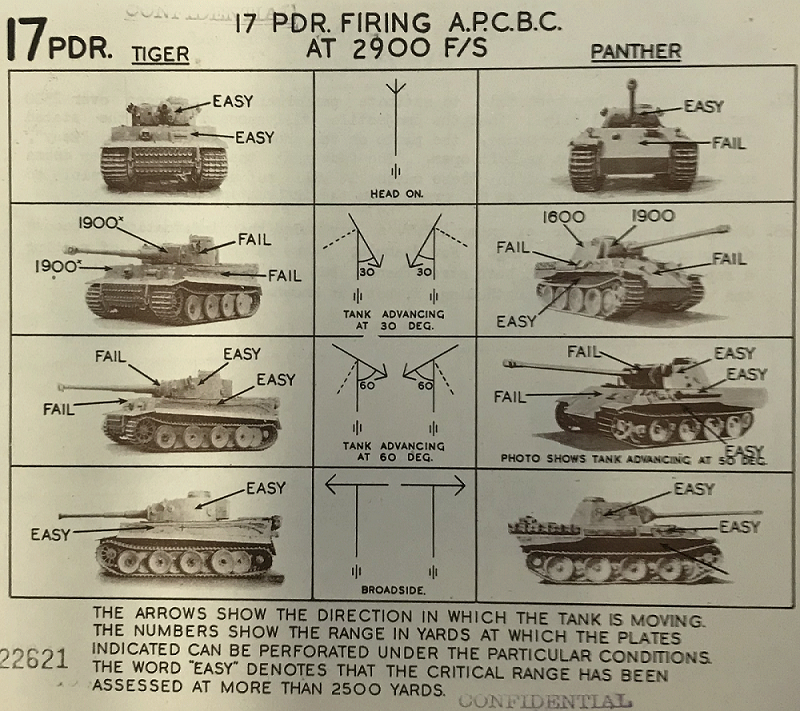
Theory soon turned into practice. New instructions on fighting Panther tanks based on experience gained in Normandy were published on July 19th, 1944. This manual still considered the upper front plate a tough nut to crack, but it was no longer treated as invulnerable. 17-pounder APCBC shot fired at 200 yards could knock out a plug or even penetrate completely. The other guns still had to aim at the mantlet. The instructions suggest firing 75 mm and 105 mm HE at the gun mantlet, since the resulting shockwave shattered the roof of the driver’s compartment. AP shells of all calibres could also ricochet down from the gun mantlet and also penetrate the roof. Hitting the left or right edge of the lower front plate would damage the final drives.
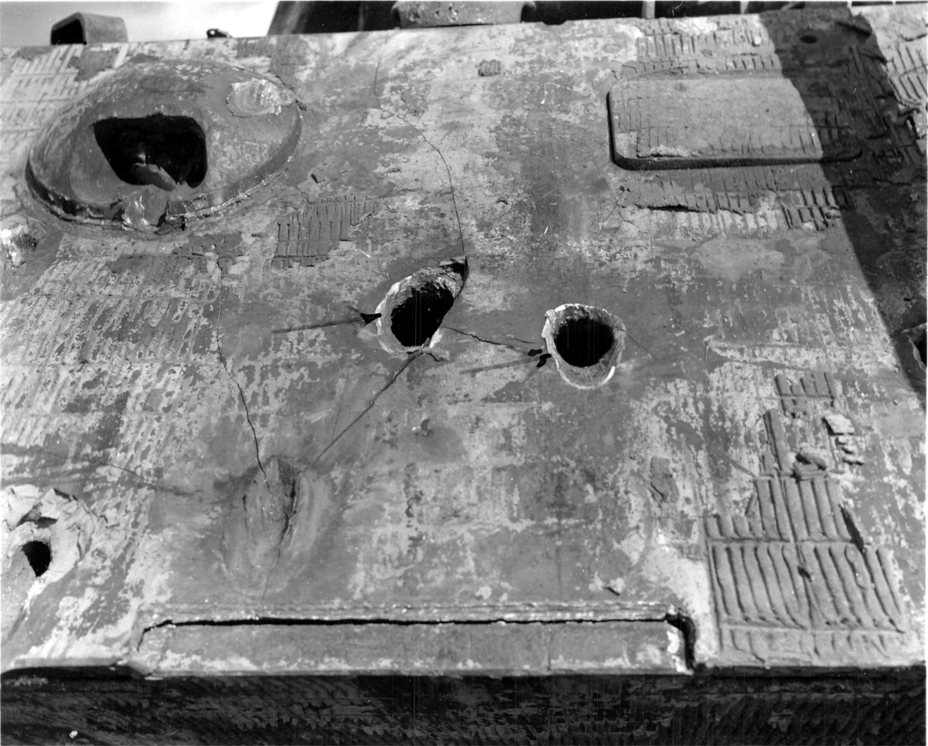
The data regarding penetration of the sides didn’t change, but results of firing from a 75 mm gun were appended. The M61 shell penetrated the side of the turret from 1750 yards, the sloped hull side from 1000 yards, and the vertical side from 2000 yards or greater at an angle of 30 degrees. HE shells could be aimed at the side between the track and pannier floor. The instructions noted that if the tank had its skirt armour, then a second shot would be needed. Separate trials confirmed that the skirts were useless against armour piercing ammunition. The hull and turret rear could be penetrated at a range of 1600 and 1750 yards respectively. The tank could also be knocked out by firing at the engine deck with any weapon. Fragments from shells bursting against the rear of the turret could penetrate the air intake louvres and enter the engine compartment.
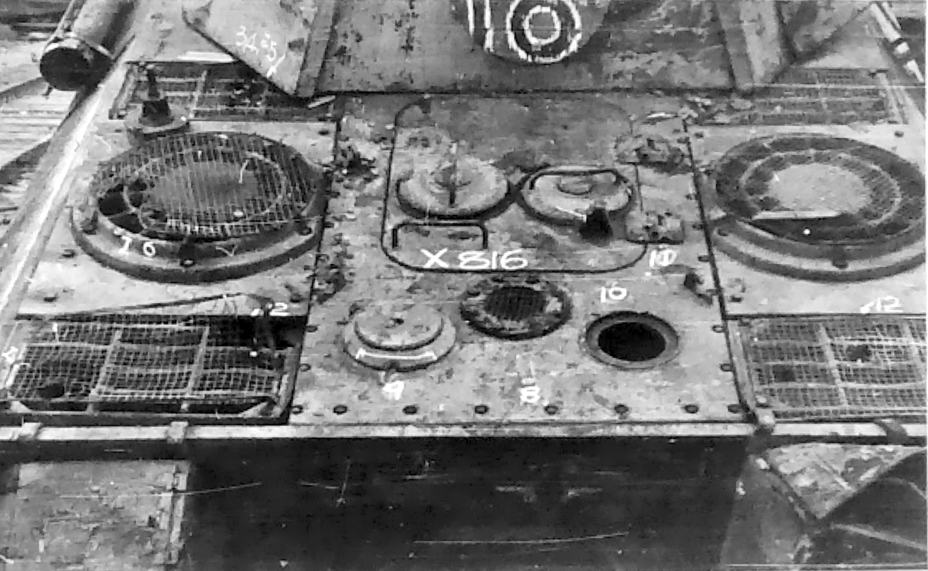
Penetration data was updated by the end of September. Reconnaissance confirmed that Panthers with thicker armour were being fielded. 6-pounder AP could no longer penetrate 120 mm thick armour, but APDS made penetrating the Panther Ausf.G’s gun mantlet possible. Older tanks with thinner mantlets could be penetrated from 1250 yards at normal or 750 yards at 30 degrees. The side of the hull and turret could be penetrated from over 2500 yards at normal or 750 yards at 43-46 degrees.
The ability of the 17-pounder to penetrate the Panther also improved compared to initial calculations. The 100 mm thick mantlet could be penetrated from over 2500 yards at 30 degrees or 1000 yards at 37 degrees. The 120 mm thick mantlet could be penetrated from over 2500 yards at normal or 1000 yards at 30 degrees. At that angle it was easier to shoot at the sides, since the 17-pounder could penetrate them from 1000 yards at 60-62 degrees. The instructions once again indicated that AP shot could penetrate the upper front plate at close range.
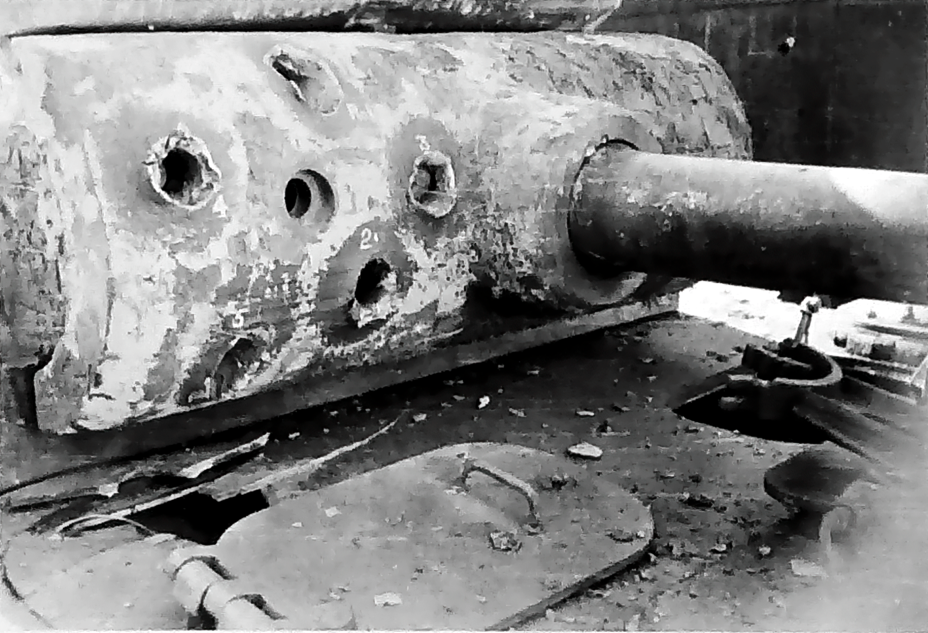
The ability of the 75 mm gun to fight the Panther was similarly revised. The sides of the Ausf.D and Ausf.A tanks could be penetrated from 2100 yards at normal, 1100 yards at an angle of 30 degrees, or 750 yards at 35 degrees. The sides of the Panther Ausf.G were tougher. They could be penetrated from 1800 yards at normal, 1000 yards at 30 degrees, or 750 yards at 33 degrees.
The report noted that the thicker roof made it more difficult to shatter the armour by hitting the gun mantlet with 75 or 105 mm HE, but no alternative existed for those guns when engaging a Panther from the front. The use of a machine gun ball mount instead of a firing port and cancellation of the driver’s vision port also made the upper front plate tougher.

Low velocity guns finally received a way to combat the Panther frontally: M67 HEAT ammunition. Trials showed that it could successfully penetrate the tank’s upper front plate, although it was preferable to aim at the top of the hull. The upper front plate could also be penetrated by captured Panzerfausts.
The British didn’t stop trials with penetration. In addition to the aforementioned mobility trials, another Panther was subjected to mobility trials at the Fighting Vehicle Proving Establishment (FVPE) in early September of 1944. The specialists examining the tank judged it to be in good condition, but British mechanics had to break a sweat to get it into working order. Even when towing the tank to the proving grounds and back to extend its lifespan as much as possible, testers could only squeeze one 20 mile run out of it. The Panther’s average speed during this trial was about the same as that of a Churchill Mk.VII. The top speed of 30 mph (50 kph) claimed in the tank’s manual was impossible to reach. The testers also didn’t like the way the suspension worked. According to them, the engine was very raw and unrefined. It would be impossible to conduct full scale trials without a large number of spare parts on hand.

Panthers were also tested in the field. For instance, comparative mud crossing trials were carried out in the Po valley on March 6th, 1945. The Panther tank competed with various Shermans and a Churchill Mk.IV. The Panther quickly got stuck in loose soil and an attempt to reverse resulted in a broken gearbox. It did not take part in the second part of the trials as the testers could not start the tank. Further trials revealed the cause of the failure. The Panther’s wide tracks offered better flotation than the Sherman, but the traction was poor, only a little better than the Sherman’s much narrower tracks.
On the hunt
No trials, tables, or instructions will help unless front line soldiers can effectively apply them. Armed with this information, British soldiers lay in wait for the Panther on the front lines. An intelligence report dated March 1944 states that no Panther had been spotted anywhere except the Eastern Front. Alarm bells started ringing in May of 1944. Intelligence showed that Panthers were being built in large quantities and would be the main tank of SS armoured regiments and motorised divisions. Intelligence reported that SS regiments contained 96 Panthers, 20 Tigers, 25 Pz.Kpfw.IV and 22 SPGs.
The first Panther fell into the hands of the British in Italy in July of 1944. The honour of knocking it out went to a Churchill tank from the North Irish Horse regiment of the 25th Tank Brigade. This was not a fair battle, as the Panther had broken down and the crew was busy working on the engine. Penetration of the turret killed one crewman, the rest fled. The tank was put back into running order, but it worked poorly. Steering was very stiff, it was not possible to engage the two highest gears even on even terrain, and after two miles of driving the driver’s compartment began to smell of burning oil. The tank was demonstrated to the commanders of the 8th Army and sent off to the UK.

British tankers formed their own opinion about these tanks. According to them, this would have been a dangerous opponent in North Africa, but conditions in Italy did not favour the Germans. The Panther’s survivability hinged on the ability to present its tough front armour to the enemy. Unfortunately for the Panther, the Italian theatre of war was characterised by short range tank duels, which made it easy to flank the Panther and hit its vulnerable side. According to the tankers, the Germans were in a very tough spot by the time the Panther went into battle. It was difficult to deal with the raw and unrefined tank while constantly retreating. Tank units were also split up into half-platoons and even individual tanks, which made service and supply much more difficult.
The large number of undamaged tanks left behind due to breakdowns or lack of fuel allowed field penetration trials to be held in large numbers. Two Panthers were tested on the coast 7 miles north of Anzio. Testers noted that their weapons were much more effective than expected. The quality of the Panther’s armour was low. Their upper front armour plates cracked when hit and fell apart after several impacts. The sides were also quite fragile. The running gear was the toughest part of the tank. The tracks withstood six Hawkins grenades and Mk.V anti-tank mines before the tank would have been immobilised.

Data from Normandy began arriving in July of 1944. German POWs revealed difficulties of using the Panthers in battle firsthand. Interrogations revealed that the Germans were well aware of the Panther’s weak sides and commanders had a reserve of Pz.Kpfw.IV tanks that stayed 1000 m behind the main force and could be deployed forward to protect the Panthers’ flanks.

The low reliability of the tank also created a lot of problems. The engine’s lifespan allowed about 700 km of driving. Performing marches over 100 km long without stopping for maintenance was ill advised, as it led to damage of the suspension. The gearbox was still one of the tank’s weak points. The third gear broke often. Drivers were instructed not to change gears too often, which would also lead to gearbox failure. Foreign objects that got into the running gear could also easily jam the drive sprocket. According to POWs, the Tiger suffered from the same problem. The availability rate of these tanks varied from regiment to regiment. In some regiments, 25% of the tanks were undergoing repairs at any given time. In others, that figure was as high as 50%. A battalion workshop could usually return a tank into service in 1-2 days. If it needed more serious repairs, it would be sent to the rear where it would be fixed in 5-10 days.
POWs revealed a long list of defects that would take a Panther off the front lines. Final drive and gearbox failures were among the most common causes. POWs reported that the third gear broke most often. One POW blamed inexperienced drivers, but himself admitted that working with the gearbox was too difficult. The engines overheated often, which could cause a fire. Track pins fell out because of poor quality retaining rings. A large number of other small defects caused by either production flaws or misuse were mentioned.

The British also learned a lot about how Panthers were used. POWs revealed that they learned battalion and platoon level tactics. Everyone was taught that fighting alone is to be avoided, but also admitted that in Normandy Panther tanks fought solo. There was also a practice of fighting in half-platoons of two vehicles.
In addition to POW interrogations, British intelligence got their hands on an article written by Heinz Guderian titled “Battle Report from a Panther battalion”. In it, he analyzes a report of successful combat by an unnamed tank unit. The article recommends firing only at long range (1500-2000 m), not presenting the tank’s sides to fire, spreading out platoons and individual tanks, and keeping a reserve one kilometre behind the front line to cover the flanks. Pz.Kpfw.IV tanks could be used if a regiment had them, but other Panthers or even Panzergrenadiers could be used. Guderian suggested using tanks en masse and concentrating fire, criticising the practice of pulling tank battalions apart. Considering the frequency of reports of lone tanks from Normandy and Italy, this advice was ignored. The tank’s low reliability was also reflected in the report. Guderian suggested transporting the tanks by rail.

These kinds of successes were not unprecedented. The Panther was indeed a dangerous opponent in situations where it could bring its gun to bear. Unfortunately, the other aspects of the tank limited these opportunities. The unreliable engine, gearbox, and running gear was likely to immobilise the tank before it even got to battle, and the armour performed much more poorly than anticipated, making the tank a lot more vulnerable than it would appear initially. Tales from Allied tankers who faced off against the Panther and lived to tell the tale make for compelling narratives, but it’s important to remember that many more never had the experience because the tank they were destined to fight simply never showed up.
Sources:
-
Dept. of National Defence / Library and Archives, Canada;
-
Canadian Military Headquarters, London (1939-1947) RG 24 C 2;







